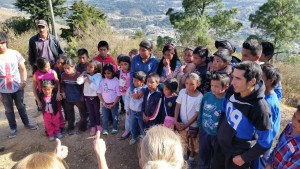Reflections from Rotary District 6000 President Elect Chris Knapp
When you visit the villages and schools in the highlands of Guatemala, throw out any preconceived notions of what a school should look like or what school supplies and materials are available to the students. You can even throw out the image you may have of the one-room school house.
On Wednesday ten of the team members and four of our Rotarian Guatemalan friends drove out of Huehuetenango and up into the highlands on an Iowa MOST outreach project. Our mission was to visit three rural schools to present a short educational lesson about oral hygiene accompanied by a song and dance routine to the school children (Dancing with the Stars and American Idol have nothing to fear from us).
Now for how the day and its activities went. We left the hotel at about 8:30. After driving almost two hours we arrived some 2000+ meters higher than when we left the hotel. Oh, did I also mention that you should forget any idea you may have about what a road is or how a road should be constructed or what is the maximum incline is that a vehicle should go up. There really wasn’t a road for half of our trip to either our first or second school. What we traveled was the ancient footpaths of the Mayan ancestors of the people we were coming to visit. The roads were rugged and our driver was applauded for his skill navigating numerous rocks and ruts.
Upon arriving at our first school the teachers and children came our of their classrooms to greet us warmly with hugs and kisses. It was a wonderful reception. This was the most modern of the three schools. There were several contiguous classrooms with doors. Also, as we traveled to each of the schools in the upper highlands there were many new latrines along the “road” and near the homes and at the schools. These latrines were constructed by the Rotarians and villagers through an $87,000 Global Grant with the Wyoming USA district. Over 200 units were constructed. These units have improved the health and welfare of the villages immensely.
Reinhard was our oral hygiene story teller. Using his horse hand puppet and the help of Paco, he talked briefly about the need for the children to brush their teeth at least twice a day, once in the morning and once in the evening. This is to get rid of the “sugar bugs” that turn our teeth yellow or black. The children shouted out the answers to his questions with much excitement and joy. After Reinhard told his dental story, we sang and danced a song about brushing your teeth in Spanish . We then passed out new tooth brushes donated by the University of Iowa Dental School.
After the song and dance routine, Paco read with great animation the children’s book “Where the Wild Things Are” by Maurice Sendak. The children loved it, and we adults got to growl and roar during the story.
The second school was even more remote. The school had two class rooms for 40 children covering kindergarten to 6th grade. Again Reinhard told his story and the MOST singers did their best. This time we pulled out all the stops. The children got tooth brushes and they all practiced brushing their teeth. Then Susie and Lindsey with the help of Brad applied fluoride to their teeth. After each child was treated they were invited to choose colorful polar fleece pieces of fabric to create their own scarves to keep them warm in the high altitude cold. Then Nienke performed her face painting magic for each student with beautiful flowers, tigers, and butterflies. They all beamed with pride at the to artwork.
The last school was the newest and at the same time the most primitive. Just a few miles outside of the city but an hour drive by car, the school is in an almost inaccessible location. It is made from tree posts with roofing sheets for the first layer of siding then plastic for the rest of the walls all atop a dirt floor.
The Rotary Club of Huehuetenago is supporting the school with the desks for the students. The future of the school is in the hands of the Rotarians as they work to raise $5000 to build a school with walls, a roof and latrines.
The children are wonderful. They are loving and trusting. The teachers are dedicated to their students. The parents are grateful for the opportunity to have their children educated. But here are the challenges. Poor facilities, poor educational materials and maybe the greatest challenge little or no access to good oral hygiene and medical care. When children are unhealthy they do not progress as they should. These are the challenges that these people face.
The people of Guatemala are industrious and resilient. If you were to visit here and talk with them, you would soon realize that by meeting their needs these people can soar.

